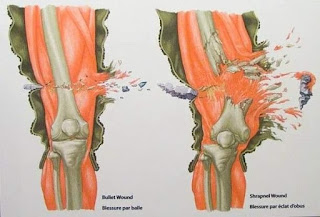Bullet: Damage & Death.
When a bullet strikes a person, it causes damage to the tissues and organs in its path. The extent of damage depends on various factors, such as the velocity, mass, shape, and composition of the bullet, as well as the location of the impact and the angle of entry.
Typically, a bullet fired from a firearm can cause three types of injuries:
Penetrating injury: When a bullet passes through the body, it creates a hole in the tissues and organs that it passes through. This can cause damage to vital organs, such as the heart, lungs, liver, or brain, leading to severe bleeding, loss of function, and death.
Cavitation injury: When a bullet enters the body, it creates a temporary cavity around its path due to the displacement of tissues and fluids. The pressure wave generated by this cavity can cause secondary damage to nearby organs and tissues, even if the bullet does not directly hit them. This type of injury is more common with high-velocity bullets.
Fragmentation injury: When a bullet hits a bone or hard tissue, it may fragment into smaller pieces that can cause additional damage to the surrounding tissues and organs. These fragments can travel further from the primary path of the bullet and can cause injury to other parts of the body.
The severity of the injury depends on various factors, such as the caliber and velocity of the bullet, the distance from which it was fired, and the location of the impact. If the bullet hits a vital organ, a major blood vessel, or the brain, the damage can be fatal. In addition, severe bleeding can cause hypovolemic shock, which can also be life-threatening.
Overall, a bullet can kill a person by causing extensive damage to the tissues and organs, leading to bleeding, loss of function, and shock.






.jpeg)

0 Comments